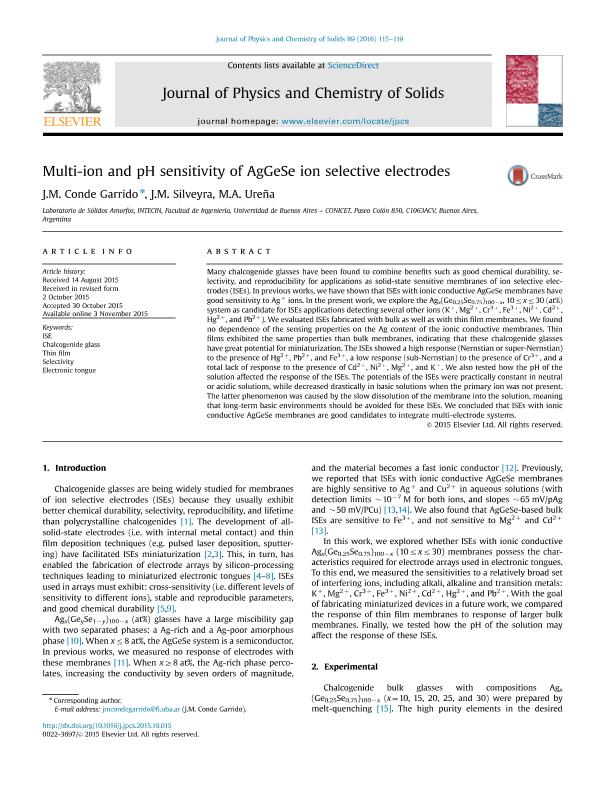Artículo
Multi-ion and pH sensitivity of AgGeSe ion selective electrodes
Fecha de publicación:
02/2016
Editorial:
Elsevier
Revista:
Journal of Physics and Chemistry of Solids
ISSN:
0022-3697
Idioma:
Inglés
Tipo de recurso:
Artículo publicado
Clasificación temática:
Resumen
Many chalcogenide glasses have been found to combine benefits such as good chemical durability, selectivity, and reproducibility for applications as solid-state sensitive membranes of ion selective electrodes (ISEs). In previous works, we have shown that ISEs with ionic conductive AgGeSe membranes have good sensitivity to Ag+ ions. In the present work, we explore the Agx(Ge0.25Se0.75)100−x, 10≤x≤30 (at%) system as candidate for ISEs applications detecting several other ions (K+, Mg2+, Cr3+, Fe3+, Ni2+, Cd2+, Hg2+, and Pb2+). We evaluated ISEs fabricated with bulk as well as with thin film membranes. We found no dependence of the sensing properties on the Ag content of the ionic conductive membranes. Thin films exhibited the same properties than bulk membranes, indicating that these chalcogenide glasses have great potential for miniaturization. The ISEs showed a high response (Nernstian or super-Nernstian) to the presence of Hg2+, Pb2+, and Fe3+, a low response (sub-Nernstian) to the presence of Cr3+, and a total lack of response to the presence of Cd2+, Ni2+, Mg2+, and K+. We also tested how the pH of the solution affected the response of the ISEs. The potentials of the ISEs were practically constant in neutral or acidic solutions, while decreased drastically in basic solutions when the primary ion was not present. The latter phenomenon was caused by the slow dissolution of the membrane into the solution, meaning that long-term basic environments should be avoided for these ISEs. We concluded that ISEs with ionic conductive AgGeSe membranes are good candidates to integrate multi-electrode systems.
Palabras clave:
Ise
,
Chalcogenide Glass
,
Thin Films
,
Selectivity
,
Electronic Tongue
Archivos asociados
Licencia
Identificadores
Colecciones
Articulos(INTECIN)
Articulos de INST.D/TEC.Y CS.DE LA ING."HILARIO FERNANDEZ LONG"
Articulos de INST.D/TEC.Y CS.DE LA ING."HILARIO FERNANDEZ LONG"
Citación
Conde Garrido, Juan Manuel; Silveyra, Josefina María; Ureña, Maria Andrea; Multi-ion and pH sensitivity of AgGeSe ion selective electrodes; Elsevier; Journal of Physics and Chemistry of Solids; 89; 2-2016; 115-119
Compartir
Altmétricas




